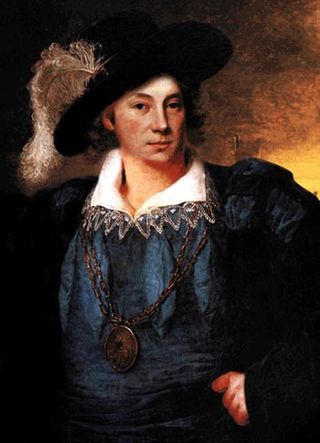Related Research Articles

Buccaneers were a kind of privateer or free sailors particular to the Caribbean Sea during the 17th and 18th centuries. First established on northern Hispaniola as early as 1625, their heyday was from the Restoration in 1660 until about 1688, during a time when governments in the Caribbean area were not strong enough to suppress them.
William Wright was an English privateer in French service and later buccaneer who raided Spanish towns in the late 17th century.
Adolph Esmit was a Danish colonial administrator and slave trader who served as governor of St. Thomas in the Danish West Indies from 1683 to 1684, and again from 1687 to 1688. He was born in Holstein. His older brother Nicolai Esmit preceded him as governor of St. Thomas.

Michel de Grammont was a French privateer. He was born in Paris, France and was lost at sea in the north-east Caribbean, April 1686. His privateer career lasted from around 1670 to 1686 during which he commanded the flagship Hardi. He primarily attacked Spanish holdings in Maracaibo, Gibraltar, Trujillo, La Guaira, Puerto Cabello, Cumana and Veracruz.

Bartholomew Sharp was an English buccaneer and privateer. His career of piracy lasted seven years (1675–1682). In the Caribbean he took several ships, and raided the Gulf of Honduras and Portobelo. He took command of an expedition into the Pacific and spent months raiding settlements on the Pacific Coast of South America including La Serena which he torched in 1680. His flagship, taken at Panama, was the Trinity.

Laurens Cornelis Boudewijn de Graaf was a Dutch pirate, mercenary, and naval officer in the service of the French colony of Saint-Domingue during the late 17th and early 18th century.
John Morris was an English buccaneer active in the Caribbean during the 1660s and early-1670s. His son, John Morris the Younger, held a command of his own ship during his father's later expeditions against Portobelo and Maracaibo. John Morris the Younger was one of the commanders killed in an explosion during a party on board Henry Morgan's flagship in 1670.

Edward Davis or Davies was an English buccaneer active in the Caribbean during the 1680s and would lead successful raids against Leon and Panama in 1685, the latter considered one of the last major buccaneer raids against a Spanish stronghold. Much of his career was later recorded by writer William Dampier in A New Voyage Round the World (1697).
Captain John Coxon, sometimes referred to as John Coxen, was a late-seventeenth-century buccaneer who terrorized the Spanish Main. Coxon was one of the most famous of the Brethren of the Coast, a loose consortium of pirates and privateers. Coxon lived during the Buccaneering Age of Piracy.
Laurens Prins, anglicized as Lawrence Prince, was a 17th-century Dutch buccaneer, privateer and an officer under Captain Sir Henry Morgan. He and Major John Morris led one of the columns that raided Panama in 1671.
Jan Willems, also known as Janke or Yankey Willems, was a 17th-century Dutch buccaneer. Based out of Petit-Goâve, Willems participated in a number of expeditions against the Spanish during the early to mid-1680s with other well-known privateers including Michiel Andrieszoon, Thomas Paine, Laurens de Graaf, Nicholas van Hoorn and Michel de Grammont.
Michiel Andrieszoon was a Dutch buccaneer who served as lieutenant to Captain Laurens de Graaf. He commanded the le Tigre, with a 300-man crew and between 30 and 36 guns. He is occasionally referred to in English as Michel or Mitchell, and is often erroneously given the nickname "Bréha Michiel".
Jean Hamlin was a French pirate active in the Caribbean and off the coast of Africa. He was often associated with St. Thomas's pirate-friendly Governor Adolph Esmit.
Jelles de Lecat was a Dutch pirate and buccaneer who sailed for and against both the English and Spanish. He served with Henry Morgan and was often called "Yellahs," "Yallahs," or “Captain Yellows.”
George Bond was an English pirate active in the Caribbean. He was known for acting in league with the pirate-friendly Governor of St. Thomas, Adolph Esmit.
Jean Fantin was a French pirate active in the Caribbean and off the coast of Africa. He is best known for having his ship stolen by William Kidd and Robert Culliford.
Francois Le Sage was a pirate and buccaneer active in the Caribbean and off the coast of Africa. He is primarily associated with fellow buccaneers Michiel Andrieszoon and Laurens de Graaf.

Edmund Cooke was a merchant captain, buccaneer, and pirate. He is best known for sailing against the Spanish alongside Bartholomew Sharp, John Coxon, Basil Ringrose, Lionel Wafer, and other famous buccaneers. Cooke's flag was red-and-yellow striped and featured a hand holding a sword.
George Spurre was an English pirate and buccaneer. He is best known for sacking Campeche and for joining a large buccaneer force which captured Veracruz.
Jean Bernanos was a French buccaneer, privateer, and pirate active in the Caribbean and across Spanish Central America.
References
- ↑ Thornton, Stuart (June 1, 2011). "Pirate in the Caribbean". National Geographic Society . Retrieved June 30, 2016.
- ↑ Calendar of State Papers, Colonial: America and the West Indies, 1574–1739, CD-ROM, London: Routledge, 2000. (pg. 519-520)
